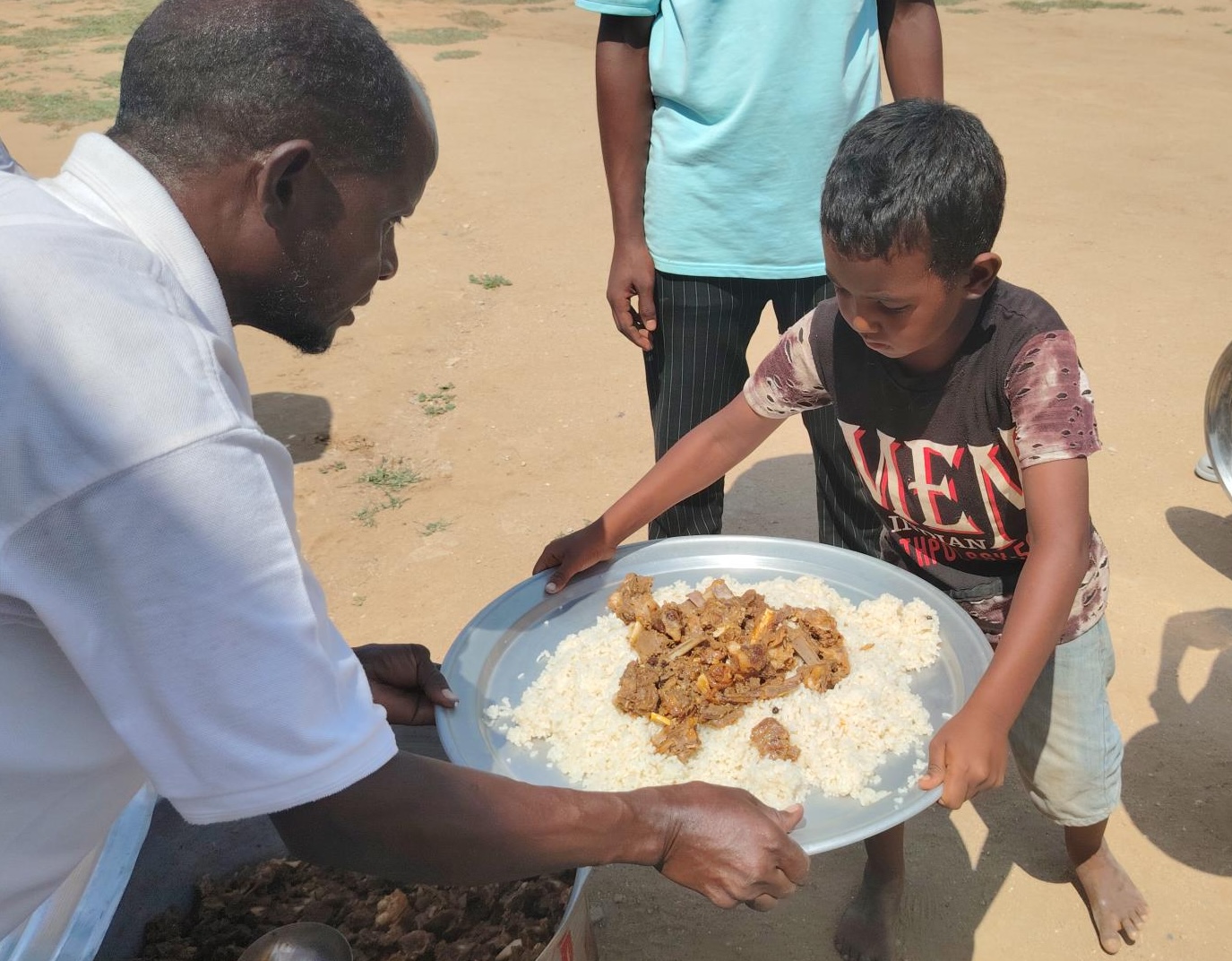$71,900,000,000.
Seventy-one point nine billion dollars—that’s how much the U.S. government spent on foreign aid in fiscal year 2023. It’s an incomprehensible amount of money. It would take the median American household more than 890,000 years to make that much. This sum dwarfs the fortunes of mere decabillionaires like Giorgio Armani, the world’s 208th richest man. If Elon Musk, the world’s richest, spent this amount of money every year, he would be broke by 2030.
But for the federal government, $71.9 billion is pocket change. In 2023, that figure represented only 1.17% of the federal budget. For every dollar in federal taxes you pay, about a penny goes toward foreign aid. Yet when a recent poll by the Kaiser Family Foundation asked respondents to guess how much of the U.S. budget is shipped to other countries as aid, the average answer was 26%—more than 20 times the actual percentage.
Despite this minuscule impact on your wallet, the second Trump administration is taking a sledgehammer to the federal government’s foreign aid programs. And that’s sending shockwaves through Minnesota’s nonprofit, NGO, and farming sectors.
Mohamed Idris is the executive director of the Columbia Heights-based American Relief Agency for the Horn of Africa (ARAHA), which works in various East African countries, including Sudan, a country that recently experienced the world’s largest displacement crisis. While ARAHA does not get funding from the federal government, the regions they serve have been affected by the foreign aid cuts.
Idris recently visited Sudan, Somalia, and Kenya. “Every time I visit there, I see the imprint of USAID,” Idris says. Even in remote areas, “You see a USAID banner there, and you see a project in a healthcare center or in a school. The impact is real.”
And the impact will be felt in Minnesota as well. Many Minnesota organizations have been directly funded by the federal government, and even those that haven’t received government money worry about how this administration’s chaotic approach is damaging the humanitarian sector as a whole.
Foreign Aid’s Past and Perilous Present
There are many legitimate criticisms of foreign aid. At times, organizations like the U.S. Agency for International Development (USAID) have acted less like charities and more like soft-power instruments of U.S. foreign policy. During the Cold War, USAID worked in concert with the CIA. In the early 2010s, the agency was embroiled in controversy after it was revealed that USAID was part of a secret effort to create a “Cuban Twitter” in the hopes of stirring up discontent against that country’s authoritarian government. In 2007, mercenaries from the infamous military contractor Blackwater, who were guarding USAID’s director, shot and killed 17 Iraqi civilians. USAID has also been criticized for not being cost-effective enough, although some steps have been taken to do better program evaluations over the years.
Musk, however, has referred to USAID as “a viper’s nest of radical-left marxists [sic] who hate America.” So far, the second Trump administration has taken a meat cleaver to foreign aid, though the administration’s attempts to gut these programs have been mired in legal disputes. On February 2, Musk tweeted that he and his team “spent the weekend feeding USAID into the wood chipper.” However, on March 3, he said that the administration was merely enacting “a brief pause to do a sanity check on foreign aid funding.” On March 26, the New York Times reported that the government sent a 281-page spreadsheet to Congress which seems to confirm that they’re trying to end most of USAID’s awards.
It remains to be seen what will ultimately happen to the funding that the administration is trying to block. There are also broader questions, such as whether Musk’s authority is even constitutional, who is actually in charge of the “Department of Government Efficiency,” and whether DOGE is ever going to evaluate any of the government programs that have supported Musk’s own businesses over the years.
While the world’s richest man gets high, plays video games (badly), and ignores calls from the various mothers of his children, lifesaving programs are in peril. One of those is PEPFAR, a State Department AIDS prevention program, first implemented during the George W. Bush administration, that the Trump administration issued a stop-work order for in January. The government claims that the program has saved 25 million lives, and an independent review recently estimated that it has saved somewhere between 7.5 and 30 million lives. That review also estimated that PEPFAR spent somewhere between $1,500 and $10,000 per life saved—he low end of that range would make PEPFAR significantly more cost-effective than the healthcare programs recommended by GiveWell, an organization that evaluates charities. At the moment, PEPFAR’s future is uncertain.
You can read thousands of articles explaining the programs that Trump, Musk, and their lackeys are trying to shred. Huge numbers of people around the world have been affected: tens of thousands of malnourished children in the Democratic Republic of the Congo; 50,000 receiving food and shelter in Colombia; 600,000 women and children who will go without maternal healthcare in Bangladesh. While the administration has reversed some cuts, one list indicates that more than a third of USAID’s programming has been slashed, according to an estimate by staffers at the Center for Global Development.
The Local, Global Community
Among the organizations that could be in the government’s crosshairs are those in Minnesota that have received government funding related to foreign aid. In addition to farmers and agribusiness, two of those organizations are Arden Hills-based Land O’Lakes Venture37, who did not respond to a request for comment, and Bloomington-based health care nonprofit HealthPartners, whose reps declined to comment. Emails to individual HealthPartners international development staff produced automated replies which said that they would be unable to respond due to Trump’s executive order.
“American farmers are providing significant food aid to some of these USAID programs,” says Nick Hayen, who works at Minneapolis-based Global Minnesota and was previously president of the Minnesota International NGO Network (MINN). “USAID programs purchased $70 million in commodities in 2024 from Minnesota companies and corporations. These funds aren’t just being sent abroad. They’re actually creating stimulus here at home as well.”
According to Idris, of ARAHA, his organization is, “a U.S. organization, but at the same time, it’s an East African-American-led organization. We have local roots,” he explains.
These connections allow ARAHA to have a better understanding of the people they serve. “We understand the culture, we speak the language. That gives a little bit better connection, better understanding,” he says. “That helps us, whether it’s in the hiring process, whether in implementation of any project.”
Idris argues that the U.S. foreign aid sector should seek out more input on their projects from people with direct knowledge of a particular area, including diasporic communities in the U.S.
“Local leadership is critical. The U.S. is a very diverse community. Here in Minnesota, we have all types of different backgrounds,” he says. “Sometimes, there are certain areas where you cannot send anybody. You can’t send a white person to Somalia, for example, you’re just putting that person at risk. But sometimes it isn’t about the color of the people. Sometimes it’s about which region they are in. In Ethiopia, for example, when there was a war in Tigray, in north Ethiopia, between the Tigray and Amhara. You cannot send an Amhara to the Tigray area to work there, because you are killing him. Understanding these dynamics on the ground is very important to make sure that you are taking the right approach.”
While ARAHA does not receive U.S. federal government funding, Idris has felt the impact of the aid cuts on the regions his organization works in. “We found out that over 60% of [non-governmental organizations] in Somalia rely on USAID, and half of these NGOs already received the stop order from the administration,” he says.
“So Much Chaos”
Karen Baumgaertner, who co-founded MINN, said foreign aid programs sometimes prioritize supporting American businesses over maximizing benefits to people in other countries. At many NGOs, she says, “There’s a bunch of people that are at headquarters just making sure that we’re following the rules and paying for international development in the way that the federal government requires, which includes very expensive programs like… you have to buy certain products that are American-made. Those are not always in the interest of the people abroad, but they are part of doing business with the government.”
According to a statement from its executive director, Pat Plonski, St. Paul-based Books for Africa has lost some funding, but will be able to keep implementing its programs with private money.
“There are others who are much more dramatically impacted than us, letting go of half their staff, two-thirds of their staff, that kind of thing,” says Plonski. “Fortunately, we’re not in that situation, but probably 10-20% of our budget will get clipped as a result of this.”
Even if the funds are restored, his organization could face difficulties in actually accessing them. “I’m assuming it’s gone,” Plonski says. “If it is still there, the people who used to implement it are gone. I don’t even know who I would ask if it’s still around, if our grant is still there. There’s just so much chaos.”
Even before the current chaos, it was hard to get federal funding. “The truth is, a small minority of international NGOSs doing humanitarian work are funded by the U.S. government,” Baumgaertner says, citing the high barrier to entry and workforce required to assemble deadline-dependent proposals.
Funding that originates with a government agency like the State Department or USAID can go through additional stages before it gets to a Minnesota organization. “Then, there’s usually another NGO, usually in Washington, D.C., that’s considered the ‘prime.’ They often get the business, and then they often work with local partners.” These secondary grants are called “subawards.”
Sense of Betrayal
The recent drama in D.C. has affected humanitarian organizations’ trust in the government. “It’s always dangerous to rely on large donors for the lion’s share of your money, whether that’s government money, whether that’s individuals, corporations,” Plonski says.
“One of the things that the U.S. government has going for it is that it always paid on time,” adds Baumgaertner. “Even if this gets figured out, there’s a crisis.”
For instance, multiple manufacturers of specialized food products that fight malnutrition haven’t been paid by the government since last year. “It’s not at all dramatic to say that it’s going to cost, at the very least, tens of thousands of lives,” Mana CEO Mark Moore told CNN.
Laura Skubic is the fundraising director at OneVillage Partners, which is based in Minneapolis and Sierra Leone. While her organization does not receive federal government funding, Skubic spoke to the state of the sector as a whole.
“It’s a devastating impact, even in this limbo time,” she says. “There’s life-saving medications and programming that’s not happening, and people are losing their lives.”
The loss of trust could also drive talented professionals away from the humanitarian sector and towards better-paying, more stable work that is not as good for the world.
“I know really, really smart people with 20 years of experience, 30 years of experience, that just got laid off. They’re going to go away forever,” says Paul Hanscom, a consultant who is on the board of MINN. “They’re going to go get a job as something else, somewhere else, that frankly is going to pay them a lot better.”
Future-Proofing
Nonetheless, some of the people Racket spoke with were hopeful that the foreign aid sector could come out of this crisis stronger than before.
Skubic was optimistic that the increased attention being paid to foreign aid will inspire private donors to step up. “Since global philanthropy is going to be more in the spotlight, it’s a chance for more private dollars to go that way,” she says. “It’s just too soon to tell what’s going to happen, and things seem to be changing every day.”
Plonski was hopeful that genuine inefficiencies could be fixed. “It doesn’t make any sense to me to eliminate these programs,” he says. “It does make sense to look at them and say, can they be more efficient?”
Baumgaertner wants the sector to rethink its perspective. “One of the things that MINN has been doing, or trying to do, is recognize that those affected by humanitarian aid are probably the best to make decisions about it,” she says. She wants organizations to include more people in their decision making, including both those who directly receive the aid and related diaspora communities in the Twin Cities.
The U.S. government doesn’t always do foreign aid right. But when it does, the taxpayers’ pocket change can have a major impact. And when that aid is cut off, it isn’t just the people overseas who suffer.







